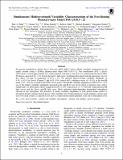Simultaneous Multiwavelength Variability Characterization of the Free-floating Planetary-mass Object PSO J318.5−22
Author(s)
Biller, Beth A.; Vos, Johanna; Buenzli, Esther; Allers, Katelyn; Bonnefoy, Mickaël; Charnay, Benjamin; Bézard, Bruno; Allard, France; Homeier, Derek; Bonavita, Mariangela; Brandner, Wolfgang; Crossfield, Ian Jm; Dupuy, Trent; Henning, Thomas; Kopytova, Taisiya; Liu, Michael C.; Manjavacas, Elena; Schlieder, Joshua; ... Show more Show less
DownloadBiller_2018_AJ_155_95.pdf (7.994Mb)
Terms of use
Metadata
Show full item recordAbstract
We present simultaneous Hubble Space Telescope (HST) WFC3+Spitzer IRAC variability monitoring for the highly variable young (∼20 Myr) planetary-mass object PSO J318.5-22. Our simultaneous HST + Spitzer observations covered approximately two rotation periods with Spitzer and most of a rotation period with the HST. We derive a period of 8.6 ± 0.1 hr from the Spitzer light curve. Combining this period with the measured for this object, we find an inclination of 56.°2 ± 8.°1. We measure peak-to-trough variability amplitudes of 3.4% ± 0.1% for Spitzer Channel 2 and 4.4%-5.8% (typical 68% confidence errors of ∼0.3%) in the near-IR bands (1.07-1.67 μm) covered by the WFC3 G141 prism - the mid-IR variability amplitude for PSO J318.5-22 is one of the highest variability amplitudes measured in the mid-IR for any brown dwarf or planetary-mass object. Additionally, we detect phase offsets ranging from 200° to 210° (typical error of ∼4°) between synthesized near-IR light curves and the Spitzer mid-IR light curve, likely indicating depth-dependent longitudinal atmospheric structure in this atmosphere. The detection of similar variability amplitudes in wide spectral bands relative to absorption features suggests that the driver of the variability may be inhomogeneous clouds (perhaps a patchy haze layer over thick clouds), as opposed to hot spots or compositional inhomogeneities at the top-of-atmosphere level.
Date issued
2018-01Department
Massachusetts Institute of Technology. Department of PhysicsJournal
Astronomical Journal
Publisher
American Astronomical Society
Citation
Biller, Beth A. et al. “Simultaneous Multiwavelength Variability Characterization of the Free-Floating Planetary-Mass Object PSO J318.5−22.” The Astronomical Journal 155, 2 (January 2018): 95 © 2018 American Astronomical Society
Version: Final published version
ISSN
1538-3881
0004-6256